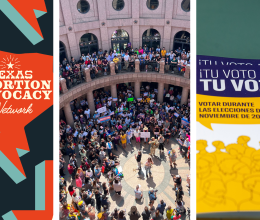Anti-abortion extremists are crisscrossing the state, pressuring Texas municipalities to adopt ordinances that would criminalize abortion in our communities. These ordinances would criminalize abortion within city and town limits in the event that Roe v. Wade was overturned by the Supreme Court. Waskom, Texas was the first city to pass the proposed local abortion ban. The all-male town council voted unanimously to outlaw abortion, with conditions so severe that, if and when the ordinance is enforced, a person won’t even be able to get emergency contraception at a local pharmacy. Since Waskom passed its ban, multiple other cities in Texas have followed suit.
This hyper-local strategy is another attempt by anti-abortion extremists to stigmatize and ban abortion in Texas. And while we’re a big state, these extreme laws may be coming to your city or town.
It’s imperative that we collectively fight to keep abortion safe and legal at the federal, state, and local levels. We are doing our best to fight against these bans, but we need you to join us as well.
That is why, together with our partners, we developed this toolkit so Texans can take action to fight back.
In this toolkit you will find:
- Six steps to fight extreme anti-abortion restrictions in your community;
- Guidelines for having a successful office visit with your city council members;
- Guidelines for how to talk about abortion;
- Sample testimony for city council town hall meetings;
Browse the toolkit below and share the link with others or download, save, and share when you're offline. The resources included in this toolkit were produced in collaboration with our partners:

If you weren't able to tune in to the webinar covering the toolkit, you can still view a recording of the webinar at your convenience.








